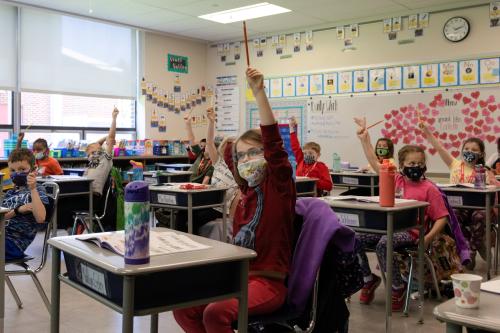High rates of teacher turnover are among the greatest barriers to building high-quality early childhood education (ECE) systems. In the United States, teachers working with the youngest learners turn over at much higher rates than those in the K-12 education system. For instance, our recent work shows that nearly half of child-care teachers in Louisiana leave their jobs from one year to the next. The pandemic made these already severe staffing challenges even worse. Center directors say they are struggling to keep and hire teachers and are therefore turning many families away.
Public investments in ECE programs are supposed to yield dual benefits: learning opportunities for children at a particularly formative life stage, and critical work supports for families and the economy. Teachers leaving at such high rates severely undermines both. Children learn less when they cannot form stable, attached relationships with their caregivers. Professional development initiatives are wasted when so many teachers leave before they can apply what they’ve learned. Centers cannot operate classrooms, or must shut down altogether, when they cannot recruit and retain enough teachers. And when child care isn’t available, parents cannot return to work and the economy cannot recover.
It is not surprising that turnover rates are so high in a sector where the work is hard but the pay is insufficient to cover even basic needs. Nationwide, child-care teachers are paid an average of $12 per hour and nearly one-quarter report not having enough money to pay for food. Many early educators can find higher-paying, lower-stress jobs outside of child care.
To address these high rates of churn, many states are now using federal COVID-19 relief funds to roll out bonuses and financial incentives for child-care teachers in the hope of stabilizing this workforce. It is not yet clear how much these short-term funds are helping. And more generally, there is surprisingly little evidence on the link between compensation increases and teacher stability among early educators. That’s why—in partnership with the Virginia Department of Education, the Virginia Early Childhood Foundation, and our colleagues Molly Michie and Vivian C. Wong—we conducted a recent experiment to examine this issue.
Virginia’s Teacher Recognition Program
In 2019, Virginia received federal funding from a Preschool Development Birth through Five grant (PDG), and allocated a considerable portion of their funds for direct financial incentives to early educators. The goal of this program, the Teacher Recognition Program (TRP), was to recognize teachers’ hard work, lower their financial stress, reduce turnover, and create more stable early learning opportunities for children. Teachers were eligible so long as they worked for at least 30 hours per week with children aged 0-5 at any site participating in the PDG (including both child-care centers and school-based pre-K programs). If they maintained these requirements over an eight-month period, teachers could receive $1,500.
For 25 of the 26 Virginia cities and counties participating in the PDG that year, all teachers who worked at PDG sites and met these requirements were eligible. However, in Fairfax, the most populated county in Virginia, there was insufficient funding to serve all eligible teachers, so the state allocated the limited resources through a lottery. Specifically, 50% of participating sites were randomly assigned to participate in the TRP, and all eligible teachers at those sites could participate in the program. The other 50% of sites were ineligible; their teachers did not receive any outreach about the TRP and could not receive any funds through the program. This lottery, which was viewed as the most fair approach to allocating limited resources, allowed us to conduct the first-ever experiment of whether financial incentives reduce teacher turnover in ECE.
The answer was a resounding yes.
The Effects of Financial Incentives for Teachers
Teachers at sites that were randomly assigned to the TRP were far less likely to turn over. About one-quarter of all teachers at sites without access to incentives left their site within eight months (see Figure 1 below). Only 14% of teachers eligible for the incentive did.
The results were even more striking among child-care teachers: The financial incentive cut turnover rates in half, from 30% to 15%. The financial incentive had no impact on turnover for teachers working in school settings. This may reflect differences in financial well-being across sectors; in our sample lead teachers in schools received double the annual earnings of lead teachers at centers, despite working for fewer months during the year relative to teachers at centers who work year-round.
When we surveyed teachers who received the financial incentive after the end of the TRP, nearly all (89%) reported the extra funds helped them offset personal and family-related expenses, including food and rent. One wrote, “It meant I could continue to go to work and not worry about food, car bills, or my child’s care.”
What can these pre-pandemic findings tell us about the current context?
Our results provide strong evidence that, at least in the pre-pandemic context, a $1,500 incentive had a large impact on teacher retention among child-care teachers. For our partners in Virginia, this finding led state lawmakers to supplement federal dollars for the TRP with an additional $8 million over two years. With this state investment, Virginia was able to expand the TRP to more child-care teachers and provide more funds per teacher. Now in its third year, Virginia has committed to serving over 6,000 eligible teachers in child-care centers statewide and giving teachers up to $2,000.
Although we do not have experimental evidence on the impacts of Virginia’s incentive program on turnover during the pandemic, survey findings from summer 2021 indicate that nearly all teachers who received the funds used them to offset basic expenses (e.g., food and housing) and manage COVID-19-related challenges. Overall, two in five eligible teachers reported the funds led them to stay in their positions longer than they otherwise would have. One explained, “It has never seemed fair to me that the children who are from poorer families have to suffer through a revolving door of less qualified teachers. This grant helped to stabilize our center and encourage young teachers to stick with teaching.” Together, the findings from our multiyear evaluation of the TRP provide encouraging news for states attempting to use COVID-19 relief funds to support teachers and stabilize the child-care sector through financial incentives.
At the same time, reliance on one-off grants or temporary pandemic relief funds—even ones as effective as Virginia’s TRP was in the short term—is not a sustainable solution to this sector’s long-standing staffing challenges. While we do not yet know the impact of the recognition program beyond the eight-month program period, we do know that educators who care for and teach young children cannot do their jobs well, or at all, when compensated at levels that fail to cover their basic living needs. Their employers lack the funds to raise wages, and raising already high prices for families is not a feasible solution either. In this context, a relatively small amount of money helped teachers stabilize and stay at their jobs.
But there is quite a distance between providing this type of short-term support and the larger, more sustainable investments needed to foster high-quality early learning opportunities. Reliable, long-term funding streams to cover the true cost of early education—including higher wages for child-care teachers—are needed if states wish to see the kinds of returns on investments that effective ECE programs can provide.
President Biden’s Build Back Better plan would provide this type of transformative funding, giving states the financial resources and supports needed to meaningfully improve child-care quality in part through compensation reforms. However, getting the bill through the Senate has proved difficult, with growing calls to cut key pieces. Finding a way to pass this legislation, including the investments in the teachers who care for and teach our youngest children, is essential–not only for the struggling child-care sector, but for the economy as a whole. Public investments in early educators are long overdue, and they are imperative for meeting the needs of children, parents, and society.
The Brookings Institution is committed to quality, independence, and impact.
We are supported by a diverse array of funders. In line with our values and policies, each Brookings publication represents the sole views of its author(s).







